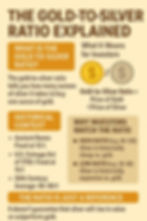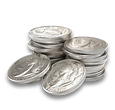Precious Metal Ratios Explained: Gold-to-Silver, Gold-to-Platinum, Platinum-to-Palladium, and Beyond
- GoldsilverJapan
- Aug 24
- 3 min read
When investors look at gold, silver, platinum, and palladium, they often ask: “Which one is undervalued right now?”
The answer isn’t always obvious. That’s why professional traders use ratios—comparisons of one asset’s price against another—to understand relative value.
The most famous of these is the gold-to-silver ratio, but it’s far from the only one. In this article, we’ll explore:
Gold-to-silver ratio
Gold-to-platinum ratio
Platinum-to-palladium ratio
Dow-to-gold ratio
Real estate-to-gold ratio
And why thinking in ratios helps you see hidden value across markets
What Is a Ratio in Investing?
A ratio compares the price of one asset to another. It helps investors answer:
“Which asset is cheap relative to another?”
“When should I switch from one to the other?”
👉 Formula:Asset A ÷ Asset B = Ratio
Example: If gold is $2,000 and silver is $25, the ratio is 80. That means one ounce of gold buys 80 ounces of silver.
The Gold-to-Silver Ratio
The classic. This ratio tells you how many ounces of silver equal one ounce of gold.
Ancient Rome: ~12:1
U.S. 19th Century: ~15:1
20th Century Average: 40–60:1
2020 Pandemic: 120:1 (record high)
Recent Years (2025): hovering around 80–85:1
How investors use it:
High ratio → silver is cheap, buy silver.
Low ratio → silver is expensive, buy gold.
⚠️ But beware:
This is just a reference tool, not a crystal ball.
You must account for premiums and spreads (silver premiums are usually higher unless you buy 1000 oz bars).
Switching metals twice (silver → gold → back) may mean double taxation and timing risks.
The Gold-to-Platinum Ratio
Platinum is 30x rarer than gold in the Earth’s crust, yet for most of modern history it traded above gold.
In the early 2000s: Platinum often traded at 1.5–2x gold.
After 2008: Gold surged while platinum lagged.
Today: Gold often trades at 1.5–2x platinum.
👉 Formula:Gold price ÷ Platinum price = Ratio
Example: If gold = $2,000 and platinum = $1,000 → ratio = 2.
Why it matters:
A high ratio suggests platinum may be undervalued.
Industrial demand (catalytic converters, hydrogen energy) could drive platinum higher.
The Platinum-to-Palladium Ratio
This is a favorite among industrial metal watchers.
Historically:
Platinum used to trade at a premium to palladium.
But from 2016–2022, palladium surged (due to auto-industry demand), and the ratio flipped.
👉 Formula:Platinum price ÷ Palladium price
If platinum = $1,000 and palladium = $1,500 → ratio = 0.66.
Investor takeaway:
When the ratio is low, platinum might be the better value.
If palladium demand weakens (e.g., electric vehicles reduce catalytic converter use), platinum could regain dominance.
Beyond Precious Metals: Other Key Ratios
1. The Dow-to-Gold Ratio
This compares the U.S. stock market (Dow Jones Industrial Average) to gold.
👉 Formula:Dow Jones Index ÷ Gold price
In 1929 (Great Depression): Ratio fell toward 2.
In 1980 (gold peak): Ratio dropped near 1.
In 2000 (stock bubble): Ratio hit ~44.
Today: Ratio is around 15–18.
Why it matters:
High ratio → stocks expensive relative to gold.
Low ratio → gold strong, stocks cheap.
Some investors use this to decide whether to favor equities or gold in their portfolio.
2. Real Estate-to-Gold Ratio
This ratio asks: “How many ounces of gold does it take to buy a house?”
In 1970s: Gold was so undervalued it could take over 600 ounces of gold to buy a U.S. median home.
In 1980 (gold spike): Just 100 ounces.
In 2001 (gold low): Over 500 ounces again.
Today (2025): Around 250–300 ounces for a median U.S. home.
👉 Translation: Gold sometimes makes real estate look overpriced, and vice versa.
Why Ratios Matter
Ratios are powerful because they help investors see value vs. price.
Gold vs. Silver: Precious metals hedging strategy.
Gold vs. Platinum/Palladium: Industrial vs. monetary value.
Dow vs. Gold: Stocks vs. hard assets.
Real Estate vs. Gold: Property cycles vs. commodity cycles.
But—ratios are not predictions. They are reference points.
⚠️ Things to remember:
Premiums, spreads, and storage costs matter.
Taxes may apply twice if you “switch” assets.
Always think about your endgame—are you holding long-term, or selling later?
Final Thoughts
Ratios like gold-to-silver or Dow-to-gold don’t tell you the future, but they help you understand relative value.
High gold-silver ratio? Silver might be cheap.
Gold more expensive than platinum? Platinum might be undervalued.
Stocks skyrocketing compared to gold? Maybe gold deserves a second look.
Ratios are best used as part of a broader investing strategy—not in isolation.
👉 Want to trade gold, silver, platinum, and palladium without worrying about heavy bars or vaults? Try this platform for precious metals investing.







